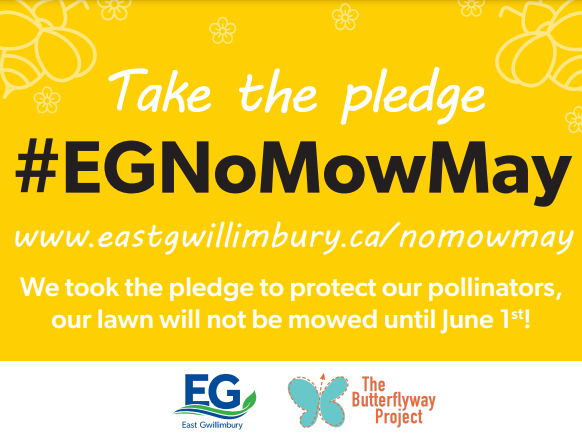
No Mow May
What is the No Mow May Challenge?
The Environmental Advisory Committee (EAC) is asking residents to help support pollinators during spring as they look for their first food sources of the season (normally dandelions or other weeds/flowers), places to hide and protection from night-time frost. Having longer grass, or leaves, around your yard gives them a safe place to shelter. This movement is important as research indicates a mass extinction of insects is underway. Of particular concern in recent years, is the decline of the bee population.
Residents are asked to avoid or reduce mowing their lawns until June with the goal of preventing disturbance of overwintering insects and amphibians that may be burrowed or hiding in leaves and lawns, and to increase food sources to pollinators. Unseasonably warm temperatures may lure them out of hiding and they need a place to retreat back to.
Our goal with No Mow May is to promote conversations about biodiversity protection and how small actions can make a difference. There are concerns about the pros and cons of this campaign and the impact it may cause. The Environmental Advisory Committee is looking into scientific, peer-reviewed research that supports or denies the benefits of No Mow May in Canada.
The Town and the Committee would like to continue learning and engaging with the community to consider initiatives to promote and enhance habitats for pollinators and healthy ecosystems for all residents. We encourage residents to look at Pollinator and Native Plant Gardening Resources to see a full list of ways to help feed the bees!
How can you participate?
Reduce, or refrain from mowing your lawn until June 1!
To register for the challenge, please complete the online form. Those who donate minimum of $20 will be entered into a draw and receive a lawn sign to show your neighbours you’re supporting No Mow May. All donations will go to the David Suzuki Foundation Butterfly Way.
Signs can be picked up at the following locations during regular business hours. Please visit the location you chose when you registered.
- Civic Centre
- EG Sports Complex
- Both library branches
Residents with mobility issues can request to have signs delivered to their home by emailing the Environment team.
No Mow May Prize
Participants who donate a minimum of $20 through the online form will be automatically entered into a draw for a gift basket from Queensville Farm Supply and Country Store, valued at $150.
| How to manage grass clippings during No Mow May |
| Grass clippings are banned at the Regional yard waste facility as well as for our curbside collection program.
Tips on how to manage grass clippings through the No Mow May event:
|
Other Ways to Participate/What you can do after May?
Whether you can participate in No Mow May or not, you can help pollinators throughout the spring and summer by:
- Planting a pollinator garden. Choose a variety of native flowering plants, such as Asters, Bee Balm, Milkweed and Coneflowers, with varying bloom times that last from spring until fall in order to provide food sources all season long.
- Choose a section of your lawn that can remain uncut all summer long.
- Decrease mowing frequency throughout the mowing season. Let your lawn grow a little longer than normal, ideally mowing only once or twice per month.
- Mow at the highest setting. This allows low lying flowers to continue to grow and decreases re-flower time for those that are mown.
The Canadian Wildlife Federation has a similar initiative underway. You can also learn more about the David Suzuki Foundation Butterfly Way initiative, here.
Contact Us
Our Customer Service Team is here to help!

